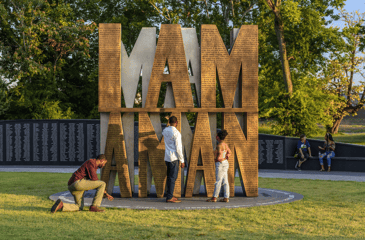Design & Build Collaboration
SWA Group Goes Over & Above to Integrate Maintenance Teams into the Development of an Urban Park
.png?width=1720&height=1176&name=I%20Am%20A%20Man%20Plaza%20(7).png) PROJECT DETAILS Build Time: 6 month | Plaza Site work: $1.8 million |
PROJECT DETAILS Build Time: 6 month | Plaza Site work: $1.8 million |
Sculpture: $700,000 | Size: .6 acre
A Memphis Plaza Honors 1,300 Sanitation Workers
& Dr. Martin Luther King, Jr.’s Final Cause
Powerful words, “I Am a Man,” are the centerpiece of a new plaza in Memphis.
.png?width=193&height=290&name=I%20Am%20A%20Man%20Plaza%20(10).png) Derived from Ralph Ellison’s Invisible Man, the slogan held special meaning during the Sanitation Workers Strike of 1968 in the epicenter of the Civil Rights Movement. In February of that year, two African-American garbage collectors in Memphis were crushed to death by a malfunctioning truck. This final straw in a litany of neglect and abuse within the city department impelled 1,300 Black men to walk off the job. Their protest for better working conditions drew the attention of Dr. Martin Luther King, Jr., who came to Memphis to support the strikers. On April 3, he delivered his famous “I’ve Been to the Mountaintop,” speech. The next day, he was assassinated.
Derived from Ralph Ellison’s Invisible Man, the slogan held special meaning during the Sanitation Workers Strike of 1968 in the epicenter of the Civil Rights Movement. In February of that year, two African-American garbage collectors in Memphis were crushed to death by a malfunctioning truck. This final straw in a litany of neglect and abuse within the city department impelled 1,300 Black men to walk off the job. Their protest for better working conditions drew the attention of Dr. Martin Luther King, Jr., who came to Memphis to support the strikers. On April 3, he delivered his famous “I’ve Been to the Mountaintop,” speech. The next day, he was assassinated.
To commemorate the 50th anniversary of the Sanitation Workers Strike and Dr. King’s death, the City of Memphis brought together a dynamic team to build a public plaza.
 John Jackson III, of JPA Inc
John Jackson III, of JPA Inc
“The mayor of Memphis had the forethought to bring on an African-American landscape architect for the work, and we were honored to be selected,” says John Jackson III, of JPA, Inc. “We worked closely with Venice, California artist and sub-consultant Cliff Garten, who developed the I AM A MAN sculpture and conceptual site plan.”
The plaza was constructed next to Clayborn Temple, a rallying site in the protest and a half-mile from the National Civil Rights Museum at the Lorraine Motel, the site where King was shot.
.png?width=1776&height=1184&name=I%20Am%20A%20Man%20Plaza%20(4).png) Marble Gates & Clayborn Temple
Marble Gates & Clayborn Temple
.png?width=252&height=380&name=I%20Am%20A%20Man%20Plaza%20(9).png)
.png?width=257&height=380&name=I%20Am%20A%20Man%20Plaza%20(8).png)
At its center is Cliff’s 12-foot sculpture with the slogan I AM A MAN. Laser cut into the giant block letters is the text of King’s “Mountaintop” speech.
“I struggled with what form the sculpture would take, and I realized the strikers had already made the sculpture through their words,” says Cliff, whose design was selected from an international competition. “You also had Dr. King’s very radical speech about corporations, the American government and the Vietnam War that are still relevant today.”
Cliff designed his sculpture with two sides, one bronze, the other stainless steel.
“When you look into the text and read it, you are seeing the reflection of yourself in Dr. King’s speech,” says Cliff. “This is a request that people face their own racism.”
.png?width=1764&height=1182&name=I%20Am%20A%20Man%20Plaza%20(2).png)
Cognizant of monuments being taken down around the country, the project team saw an opportunity to create a 21st-century experience, a new model for what monuments could be like.
“We wanted to create a horizontal space that invites people in to question history,” says Cliff.
In order to achieve this, Jackson says they focused on the entry experience, drawing in visitors to an enclosed, meditative space outdoors. The team installed two curved gates from carved marble to funnel in the visitor, with the statue as the immediate focal point.
The power of words is understood from the start of the experience. Etched into the entryway are contemplative thoughts from the public, who answered Dr. King’s question: Where do we go from here? Their answers were gathered at public meetings held at Clayborn Temple led by Memphis Urban Art Commission and spoken word artists Stephen Fox and Troy L. Wiggins.
Granite pavers create a pathway throughout the plaza and provide different viewing points of the sculpture. Etched into a large elliptical granite paving ring is a timeline of the strike. Then, anchoring the back of the plaza is a curved granite wall with the names of all 1,300 workers.
"Text is really an important piece in
the experience—it was purely didactic."
.png?width=1776&height=1182&name=I%20Am%20A%20Man%20Plaza%20(5).png) Story of the strike
Story of the strike
“There was so much powerful history to work with,” says Chris.
In order to soften the hardscape elements and enhance the visitor experience, plant design was vital.
“A site with that much hardscape doesn’t have any moving parts, so we needed to create some movement,” says John. “We planted grass along the promenade so it blows around and softens the ground plane.”
.png?width=1574&height=1170&name=I%20Am%20A%20Man%20Plaza%20(6).png)
Different grasses selected include Hameln, Mexican Feather Grass and Pink Muhly. Other plants selected for the site include willow oaks, pond cypress trees and Chinese Pistacia trees.
“We didn’t want to block the beautiful stained-glass window of the church so we selected a pond cypress since it grows narrow and has great fall color,” says John. “We planted a ring of willow oaks behind the commemorative wall to frame it. These were chosen because they are deciduous but hold their leaves until December and then drop them all at once.”
At night, the plaza takes on an entirely different feel thanks to Cliff’s lighting design. The granite dedicatory wall and marble walls are lit up with ground-level uplighting, while the sculpture is illuminated from the inside, allowing the words to glow at night.
John says the plaza has been well-received by locals and tourists alike, but one especially important group: the sanitation workers who participated in the protest more than 50 years ago.
“We had the opportunity to meet some of the workers at the grand opening, and they were quite touched.” says John. “It was really incredible.”
.png?width=2092&height=1170&name=I%20Am%20A%20Man%20Plaza%20(1).png) Sanitation Workers of 1968
Sanitation Workers of 1968
I AM A MAN Plaza is just one of dozens of Civil Rights projects JPA has completed around the country. Other significant sites include the MLK National Historic Site in Atlanta; Tuskegee University and Hank Aaron Park in Alabama; and the MLK Reflection Park and Civil Rights Museum in Memphis.
John, who grew up south of Memphis in Clinton, Mississippi, has been proud to leave a tangible legacy of Civil Rights in the South.
“Our firm is probably the foremost authority on projects specifically related to African-American culturally sensitive and significant projects,” he says. “We love the opportunity to teach the next generation about the past through our design.”
.png?width=361&height=240&name=I%20Am%20A%20Man%20Plaza%20(3).png)

Left is the mirrored side of the sculpture & Right is the bronze side
John Jackson III is President and CEO of JPA Inc., a Memphis, Tennessee firm specializing in urban design, planning and landscape architecture. He received his bachelor’s in landscape architecture from Mississippi State University and completed the Minority Executive Business Program at Dartmouth.
Cliff Garten is an internationally recognized sculptor and the founder of Cliff Garten Studio in Venice, California. Garten received a master of fine arts in sculpture from the Rhode Island School of design and a master of landscape architecture with distinction from the Harvard Graduate School of Design.

SWA Group Goes Over & Above to Integrate Maintenance Teams into the Development of an Urban Park